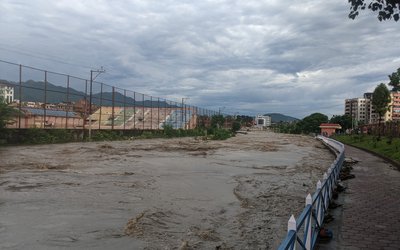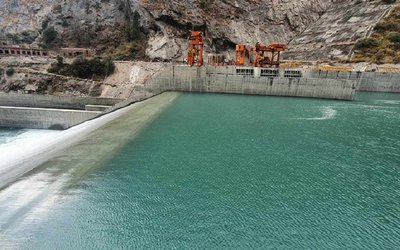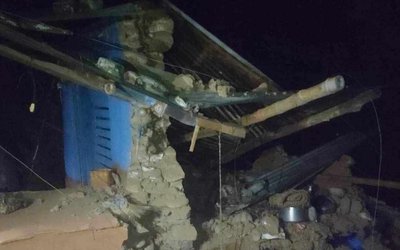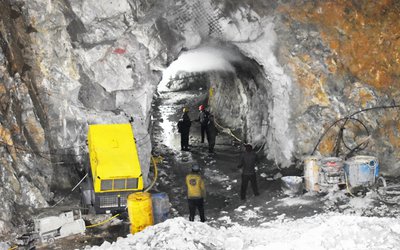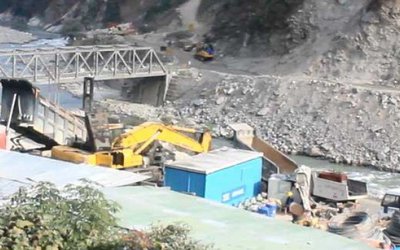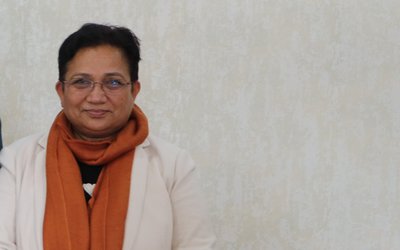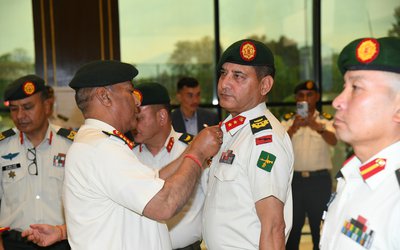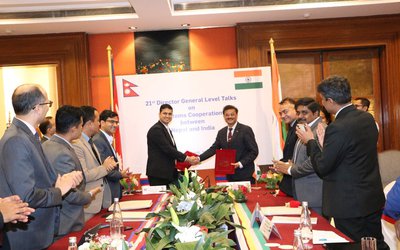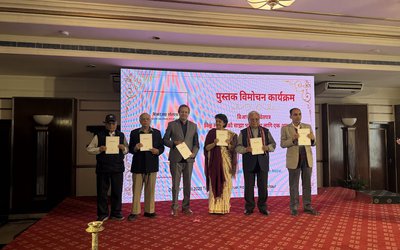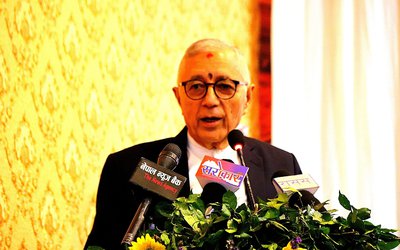
By Emma Karki, Diana Suhardiman, Patrick Drown, and Claire Swingle,
When we arrived at a fishing village called Badi on the banks of the Karnali River in Western Nepal, the doors of many homes were locked. No sounds of children playing, no beating of rice, and certainly no sounds of laughter could be heard. The Badi community consists of Dalits (the most repressed community in the caste system in South Asia) who previously travelled as musicians, performing mostly at weddings, but now fish in the Karnali river for their livelihood. After passing several homes, we met a family perched on two small beds facing each other. Sitting in a small room that functions as a bedroom, kitchen, and dining room, this family is one of the few families still residing by the riverbed; most other fisherman have decided to go elsewhere. Faced with limited livelihood options, the family depends on the fish of the Karnali river for food and they shared their hope that the flow of the river will not diminish.

Interview with Badi community members in Ramaghat village, Dailekh [image by: Diana Suhardiman]
For some of Nepal’s most fragile communities, like those living in Badi, rivers not only support livelihoods, but are the sole lifeline. As new development and hydropower projects take shape in West Nepal, threats to many of these communities are intensifying as river and water resources are subject to change.
Plans for the Karnali
One planned project in the Far West is the Upper Karnali Hydro Electric project (“Upper Karnali”). With a budget of USD 1.15 billion, the Upper Karnali (900 MW) is a colossal undertaking of a private Indian company, GMR. The project has been in the making for a decade. A memorandum of understanding between the Government of Nepal (GoN) and the hydropower company was signed in 2008, with a detailed project report completed in 2011. Local communities heard about the planned project for the first time from their respective Village Development Committees (VDCs) in 2012, after which Upper Karnali Concerns Committees (UKCCs) were formed.
The project has encountered routine delays and issues regarding land acquisition and attacks on its offices, which have cast doubt on GMR’s ability to complete the project. But a larger question remains over whether the project should be undertaken at all, and this question cannot be answered without consulting local communities.
The Upper Karnali project will directly impact 426 households in Dailekh, Surkhet and Accham districts, an area inhabited largely by fishing communities and small scale farmers with a heavy reliance on remittance income. Thousands of other households will be impacted downstream. To find out what these households think of the project, we conducted a series of focus group discussions with different UKCC members and farmers as well as villagers from 8 villages along the Karnali River in May-June.
For the upstream communities (Asaraghat, Thalpata, Sisne and Daba), the few thousand jobs coming on the heels of the project are an important point. As many in the area currently migrate to India for better wages, a new influx of jobs could mean that they may not need to migrate for good employment. One member of a Concern Committee, established to liaise with GMR, who currently resides in one of the villages that will be affected during the dam construction phase, is quite supportive of the project and wanted to ensure that our report does not portray the dam in a negative light.
“Many have come from Kathmandu to conduct research only to go back to write a report that talks about the negative effects of the project. They stay in their air conditioned offices and nice homes and criticise the dam. Do they not see how we are living here? Our villages have never seen development; the government has not developed our area. Finally we have some jobs coming and now the so-called experts want to stop that as well. I want to make sure your research does not do the same” (phone interview with UKCC member from Thalpata, Accham June 2018).
The construction of the dam also presents an opportunity to open new businesses to cater to the workers who will be hired and who will require food and lodging. One tea shop owner in Daba village shared that, if the project is to go forward, he expects a boom in business, envisioning at least a thousand workers coming into his shop to eat lunch. That would be a stark contrast to the often empty shop he currently runs.

The tea shop owner, seated with his daughter and his shop [image by: Diana Suhardiman]
Any kind of major infrastructure development also brings expectations of better roads, bridges, and mobile towers. For some displaced households, the land compensation provided by GMR would allow them to purchase land in the lowlands of the country adjoining India, which would provide better farming conditions, and better access to education and market facilities. For the upstream communities, the prospects of profiting from the project are diverse.
It is a high priority for GMR to engage upstream communities to ensure access to the land where the dam is to be constructed, and so these communities have a more direct line of communication to GMR. With this large bargaining leverage, members of the UKCCs were able to negotiate a land compensation amount with GMR that exceeded both the designated government price and the price initially quoted by GMR. Initially the company had proposed to pay NPR 500,000 (USD 4,520) per ropani (500 square metres). UKCC members had proposed NPR 15,000,000 NPR per ropani but later agreed to settle at NPR 8-9,000,000 NPR per ropani. The government was not part of the negotiations.
As one UKCC member from Sisne said, “When the company did not take UKCC’s requests seriously, we would mobilize the local community to protest the planned dam project, or even padlock the company field office, then located in Daba village.” The company has also built a mobile network tower and a pedestrian suspension bridge in the affected villages in Dailekh. Our conversations highlighted the role of this private company as a primary decision maker in hydropower development, to whom upstream communities turned in order to convey their development needs and concerns, unmet by their own government.
A different story downstream
As we travelled downstream from the Karnali from the dam site, the lucrative business scenario that many upstream villagers envision lost its steam; downstream communities, such as Ramaghat, Saura, Salkot, and Lower Dungeshwor, have less access to information and more concerns about uncompensated losses. While members of the Concern Committees upstream have been in frequent contact with project officials, the level of engagement and access to information for downstream Committees has been much lower. Unlike upstream village UKCCs that were formed in 2012, UKCCs from downstream villages were formed only later in 2013. Also, unlike in upstream villages where a UKCC was formed in each VDC that would be affected by the planned hydropower project, in downstream villages only one UKCC was formed out of the three villages that would be impacted by the dam.
This has fostered general mistrust amongst members, and a refusal by the company to establish inter-village Concern Committees has further hampered a unified voice from emerging. Intra-community dynamics, too, have further undermined the representativeness of these groups; for instance, the fishing communities, comprised mainly of Dalits, are not part of any of the UKCCs formed.

Ramaghat village, Dailekh [image by: Diana Suhardiman]
“I do not think that the planned hydropower project would benefit villagers. Even when we would get free access to electricity, this would not benefit us if it means we have to lose everything else related to our farming activities. What is the use to turn on the light and see that you have lost all your farm land due to water scarcity? At present we have sufficient water supply for our farming activities. When the dam is build, it would take all the water and impact 10,000 households in three villages in Surkhet district” (interview with villager from Saura, Surkhet, May 2018).
Downstream communities, like in Surkhet, are more concerned about the lack of water once the river is dammed than potential business opportunities, which are unlikely to manifest themselves so far from the dam. Communities along the river in Lower Dungeshwor, Dailekh are concerned with a loss in biodiversity, the direct impact on the fishing communities who rely completely on the Karnali river to sustain their livelihoods, and cultural and emotional losses – such as the joy of being able to listen to the flowing river.
Although the livelihoods and food security of downstream communities will be greatly affected by the dam, they are not eligible for compensation because they will not be directly displaced. Even this, though, is still not well-known to downstream communities, even to the UKCC members who are supposed to be the source of information about dam activities.
As one UKCC member from Saura village noted in an interview in May 2018, “I am not sure as to whether the company would give farmers any compensation. The company should provide alternative livelihood options for affected villagers, especially when the planned hydropower project would badly affect 400-500 households relying mostly on agricultural and farming practices. However, until now, we have not heard anything from the company.” A farmer from the same village echoed this uncertainty, saying, “At present we are food secure. We do not have any cash but we are fine. When the dam project comes, perhaps we would get cash for compensation of our loss of agricultural land. But we do not know how much and whether it will be enough to secure our food needs for the long term.”
This sentiment was heard from fishing villages in Badi, too. GMR has been able to overlook these needs and concerns since these communities are situated farther from the dam and the project can move forward with or without their support.
We went to the far west, as part of USAID’s Digo Jal Bikas project, to listen to local perceptions about the Upper Karnali Hydro Electric project. What we heard is that local voices are not homogenous and much of a community’s perception about the dam can be spatially fragmented, dependent on its proximity to the proposed dam site and, therefore, to bargaining power, information, and benefits.
Amidst the ongoing process of federalism and with a large number of development projects proposed, we must keep prominent in the discourse the need to incorporate local community views into decision making processes if we are to have regionally appropriate infrastructure that captures community development needs, priorities, and aspirations. This holds true, too, of any MOUs or agreements that the government enters into with private companies rather than publically administering. GMR is a private Indian company with no mandate in its contract to ensure small Nepali communities downstream benefit from the project. And the company is well aware of that, as attested to by its relationship – which could even be called a spatial alliance – with upstream UKCCs and communities but lackadaisical communications with downstream communities. Yet, without considering these local voices and the spatial fragmentation of power, hydropower development runs the risk of increasing socio-economic inequity and further marginalizing the poorest and most vulnerable, the opposite of the often-touted vision of hydropower as “Nepal’s passport out of poverty.”
Emma Karki is a Research Officer, Agriculture and Water Resources, with the International Water Management Institute (IWMI) Nepal, where Patrick Drown was the former communications specialist, and Claire Swingle is a Partnerships and Knowledge Management Fellow. Diana Suhardiman is a Senior Researcher and Research Group Leader, Governance and Gender, IWMI.
This article first appeared in The Third Pole Net. Courtesy: The Third Pole Net
